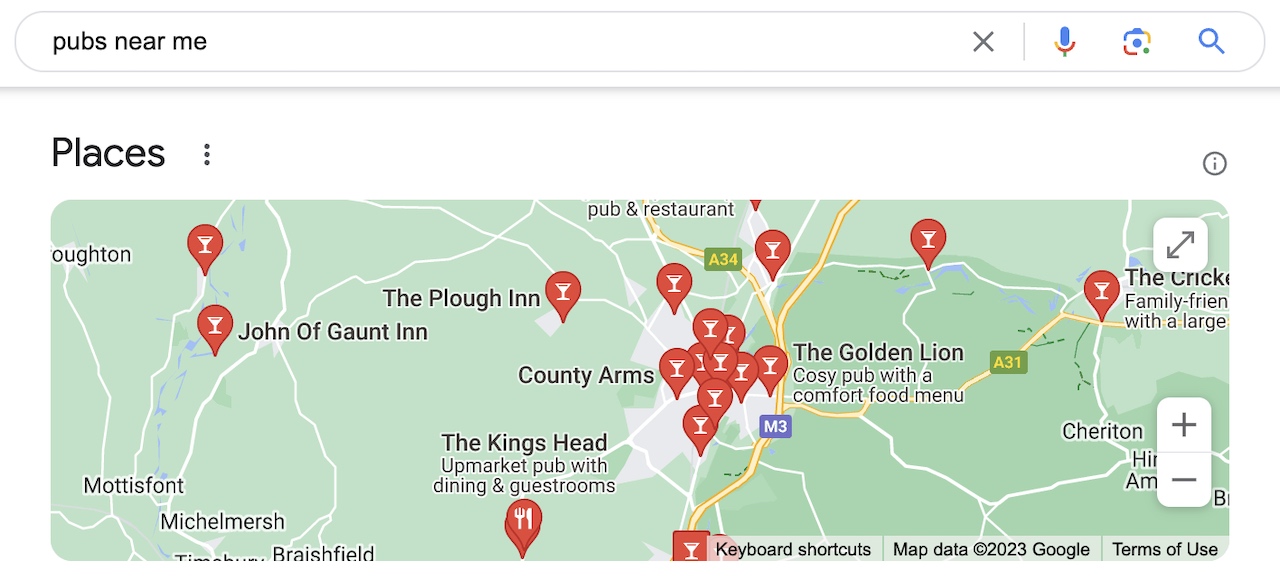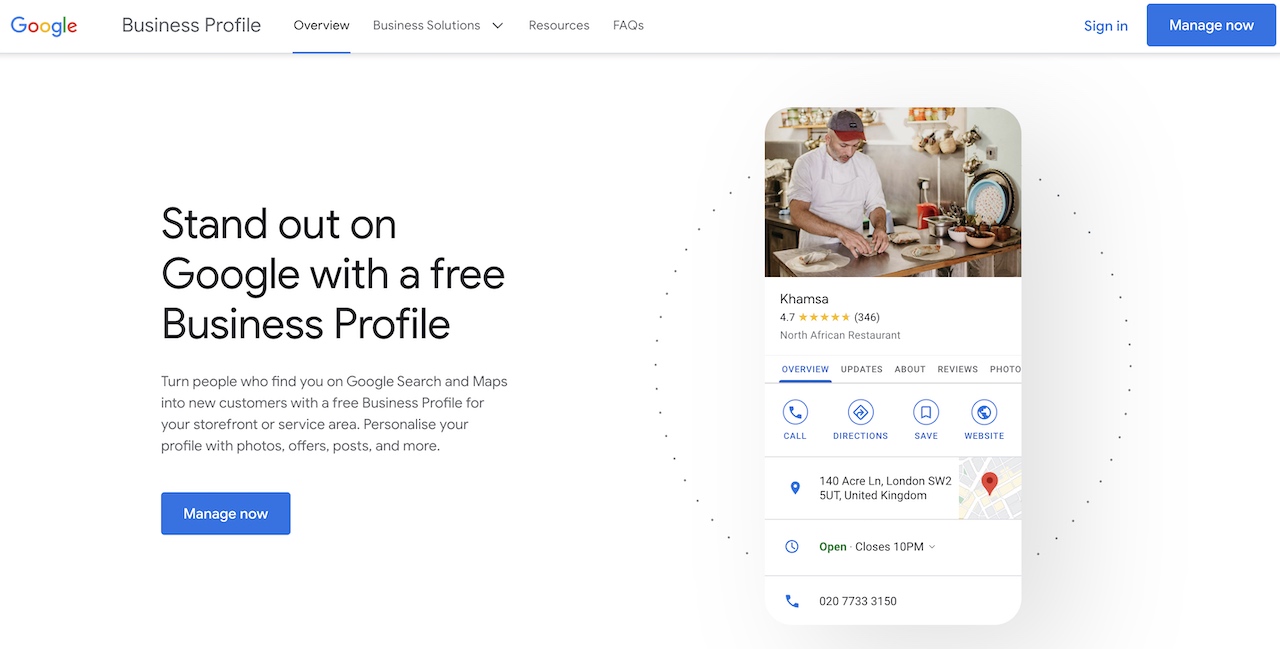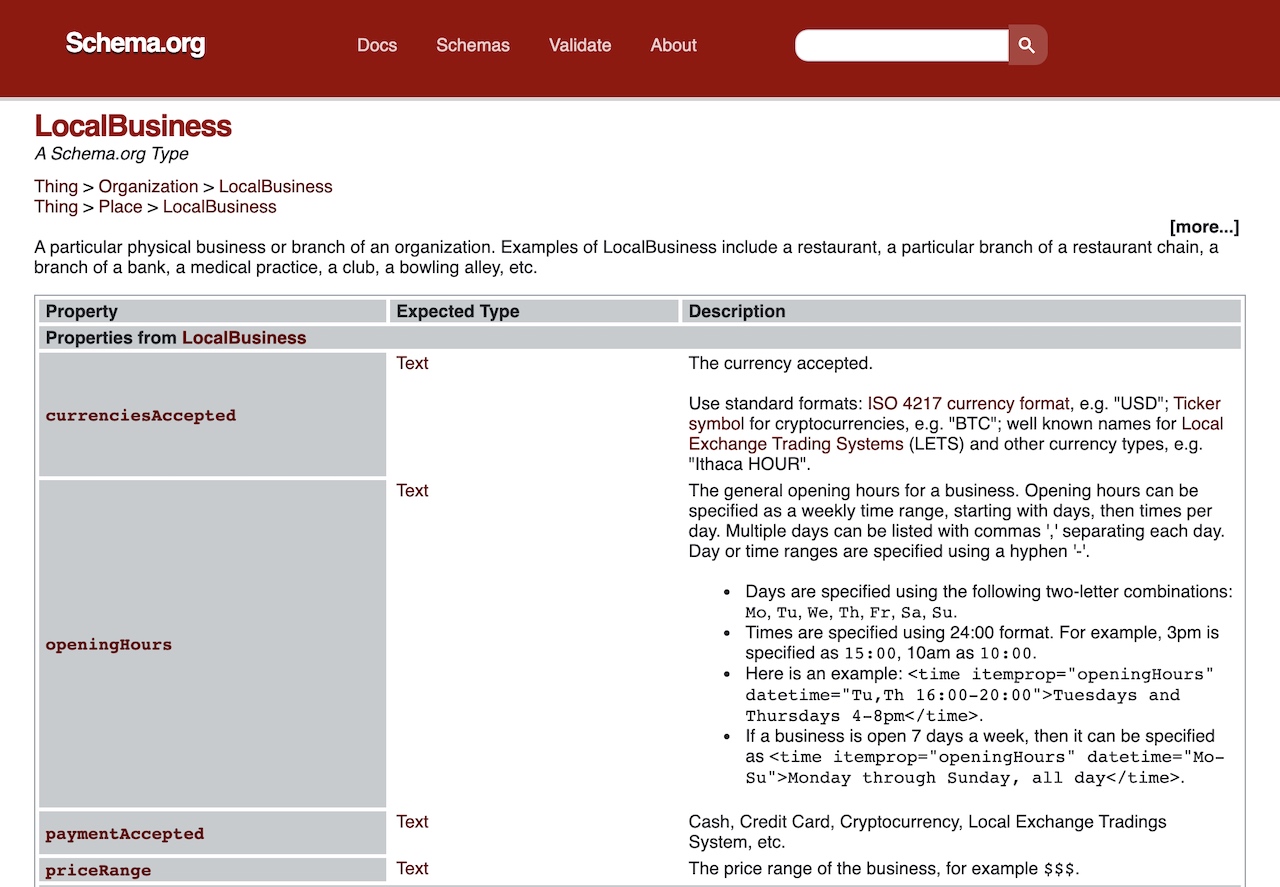“Near Me” SEO Searches
What Are “Near Me” Searches?
"Near me" searches are a type of search query that people use to find businesses, services, or points of interest in close vicinity to their current location. These searches often involve the use of geolocation data from the user's device to identify relevant results based on geographic distance. They are commonly used on search engines like Google or Bing, as well as on map-based apps like Google Maps or Apple Maps.
For example, when this person searches "pubs near me", it shows all of the pubs in the Winchester area that are close to their current location:

Why Are “Near Me” Keywords Important?
“Near me" searches are typically used when people are looking for specific types of venues or services in an area or while traveling. For example, they might search for "restaurants near me," "petrol stations near me," or "pharmacies near me”. These keywords are important because they more often than not imply a commercial intent, meaning that the user is considering purchasing something and is looking for a local store or vendor to purchase it from.
“Near me” queries can be helpful for users to discover local businesses and services that they may not be aware of. If your local business is optimized for “near me” searches, then it is more likely to show up in search results when these types of queries are searched.
Another reason why they are important is that the demand has increased with the rise of mobile device use, mobile network access, and other technologies. From 2013 to 2017 there was a 900% increase in "near me" searches, indicating that there is a huge increasing demand for these queries.
Search Intent of “Near Me” Searches
When a user searches using “near me” in their query, it means they are looking for answers right now, to find a physical location to visit or make a purchase, either immediately or soon.
There are three elements that local businesses need to fulfill within “near me” searches:
Be There - Anticipate users’ intentions in your industry before they happen, so you can be there to help fulfill their query in those moments
Be Useful - Provide relevant answers to the customers’ queries that fulfill their needs
Be Quick - The faster you can provide a piece of information for your customers, the better, as these tiny moments of opportunity come and go quickly
Are “Near Me” Searches Considered Keywords?
Although these queries are typed into a search engine like any other search, any query with the terms “near me” or equivalent, is treated as a proximity indicator by Google rather than a keyword phrase.
What happens when “near me” is used is that Google then uses device data and locations of nearby businesses to provide local search results to the user, showing them the available venues nearby.
There are officially three ranking factors for local results that Google has mentioned:
Relevance
How closely your business matches what the user is searching for? E.g. If they are searching for “vegetarian restaurants near” the restaurants that are catered for vegetarians will be highly relevant and be prioritized in the search results over other less relevant ones.
Distance
How far your business is from the user. The closer your business is to the user, the higher it is prioritized in the search results.
Prominence
How well your business is known. The more popular and longer it’s been around, including rating and the number of third-party reviews, the more trust will build for the business and will be a factor when it’s prioritized in the search results.
“Near Me” Keyword Categories
According to a mid-2018 study by Uberall based on a survey of more than 1,000 smartphone users across the US to understand their “near me” preferences and behavior, it was interesting to see the popularities of various industries:
Food: 84%
Entertainment: 56%
Banking: 50%
Apparel: 41%
Persona Care: 38%
It was also interesting to note in the study that 93% said they were likely to click on the first two to three results. This means, if your local business isn’t optimized for “near me” terms for your industry or sector, you are missing out on a lot of potential local customers.
Optimizing For “Near Me” Searches
Let’s explore some various ways in which you can optimize your local business for “near me” searches:
List and Optimise Google Business Profile
If you don’t already have a Google Business profile, it’s important to open one by creating a new Google Business account. Once you’ve created it, then make sure you fill out and complete your profile by following these 5 simple steps:
You've probably already come across business profiles on Google before, so if you don't already have one for your business, it's quick and easy to set one up:

- 1Enter your business name, address, and complete directions using Google Maps.
- 2Provide business hours, contact information, and category details.
- 3Add photos of your services and ask for reviews on your business page.
- 4Keep NAP (Name, Address, Phone) consistent on all business profiles, including social media.
- 5Maintain accurate, comprehensive, and up-to-date business information.
Use Schema Markup
To appear in Google rich snippets, which expands your visibility in the search results, including “near me” searches, and allows users to find key business information quickly, you’ll need to add Schema Markup to your website. Schema markup is a form of structured data that tells search engines about specific pieces of information, like business name, address, phone number, business opening hours, reviews, and more.
On Schema.org there are many entity types, depending on the type of data you want to mark up. One of these types is LocalBusiness, a sub-type of Organization, where you can mark up many pieces of information about it:

Anywhere on your website that you have these pieces of information it’s important to mark them up using Schema markup language. You can visit Schema.org for a list of all supported entities and formats of structured data.
Additionally, make sure to add the homepage schema markup, which tells Google about your business and allows it to show up in the Knowledge Graph card on the right side.
Google recommends using the JSON-LD format for organization schema, which can be placed anywhere on the page, including an external file that loads after the page has loaded, making it easier to manage for large sites or those with extensive use of Schema markup.
Build Backlinks with Geo Anchor Text
To build context for both users and search engines, it’s important to make sure that anchor text, for both internal and external links, has geographical references. For example, if you have a Pizza shop on 133 Baker Street, London, then some possible anchor texts for links could be as follows: “Pizza London”, “Baker Street Pizza”, “133 Baker Street Pizza Shop”, “Central London Pizza”, etc.
Create & Optimise Location Based Pages
Create pages targeting every location of your business, and optimize them accordingly. Here are a few points on what to optimize on each page:
- 1Use a user-friendly URL structure, such as "pizzashopname.com/london/baker-street/" for a pizza shop on Baker Street in London
- 2Optimise title and meta tags for your target keyword
- 3Use location keywords in alt and title tags for images of your pizza shop
- 4Include store hours, menu, directions, and amenities in a suitable description
- 5Add an optional video of your shop with a transcription to increase relevance for the specific location
Embedded Maps
Adding embedded Google maps (or other) to your website contact page or location-based pages helps users locate your local business much faster, and also gives more context and information for search engines when they crawl those pages, so it can cross reference this to verify its location. If your business is not yet on Maps, then it’s important to set this up via a Google Business profile first.
Mobile-Friendly Website
Having a website that is optimized for a mobile-first experience is very important as most users browse the web using a mobile device that typically has a smaller screen, has a portrait aspect ratio, and may be accessing the internet from slower networks. This means that in addition to being responsive so that the layout is optimized for the best mobile experience, it needs to load quickly and be easy and quick to find the information the user needs at the moment.
Use the Google Mobile-Friendly Test to check if your website is optimized for a mobile-first experience.
For example, below you'll see that Hike's homepage is usable on mobile, based on the checks the test has carried out:

Acquire Local Links via Blogging
Maintaining and building a blog with useful & valuable content relating to your business industry, products, or services, encourages local users to share and link back to these articles, creating local backlinks that can further boost search engine rankings, especially for local searches.
Local bloggers and store reviewers also actively look for and talk about their experience at a local business and may write a blog article about their experience, or add your business to a list of top choices in a specific category. All of these possibilities can increase your business's exposure in search.
Another idea to increase local links would be to interview local influencers who know your business and would recommend it to their audience.
Conduct local surveys with your customers and publish these reports on your blog, which can easily get you authority backlinks as it’s insightful for other businesses in a similar niche.
You can also create blog posts that answer users' specific queries that provide informative content, increase conversion rates, and attract visitors to your site.
Landmarks and Neighborhood Names
To enhance your local search ranking, it's essential to include any alternative names that your business may go by in the offline world. For instance, if your store is officially called "Best Burgers," but locals refer to it as "Tasty Shack," make sure to add both names to your business profile. Additionally, including nearby landmarks can help people find your business quickly and easily.
Geocode Images
To improve your local search ranking, use original photos of your business, staff, products, and menu (if applicable) instead of stock photos. Before you upload them to your website, make sure the files are accurately named, and include the business name and location, as well as what the photo is about. For example: “female-staff-member-at-counter-in-london-baker-street-pizza-shop.jpg”.
Additionally, make sure to include accurate and optimized alt tags and title tags for the photos, using your target keywords as tags to increase your chances of ranking higher in local search results.
Local Citations
Including the aforementioned Google Business profile, also make sure to add your business name and information to Bing, Yelp, Facebook, Instagram, Apple, and other local citation directories so that customers that use those platforms instead can also easily discover your business and locate it in their vicinity.
Here is a list of some of the other popular citation platforms that your business can be submitted to:
Make Customer Feedback Visible
Encourage customers to leave online feedback to build up your review profile and showcase reviews on your website. You can embed a Google Business reviews widget on your website to highlight customer reviews while they are browsing your site. If you are adding reviews manually, use schema code to display your star rating below your search engine listing and attract potential customers.
Hike + “Near Me” Searches
When it comes to optimizing your website for “near me” searches, then Hike can help small businesses to do this quickly and easily. Here are some of the different ways that Hike can empower you to do just that:
If you haven’t tried Hike yet to improve your SEO, especially local visibility, then you will be impressed by how easy it is to get started, even if you have no technical or SEO experience, it’s geared towards absolute beginners. Give it a try today!